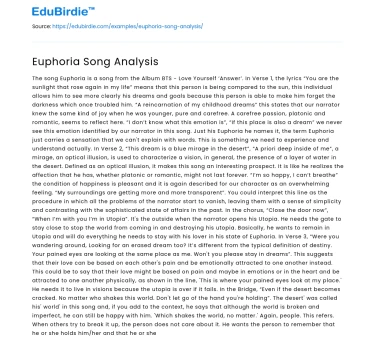Introduction
The song "Euphoria," performed by various artists over the years, stands as a monumental piece in contemporary music, captivating audiences globally with its enchanting melody and profound lyrical depth. Its widespread appeal can be attributed to the unique blend of emotive lyrics and an engaging musical composition that transcends cultural and linguistic barriers. The word "euphoria" itself denotes an intense state of happiness and excitement, and the song aims to encapsulate this essence through its dynamic structure and uplifting tones. This essay seeks to analyze the thematic and musical elements of "Euphoria," exploring how these aspects contribute to its universal resonance. By examining specific examples and considering counter-arguments, this analysis will demonstrate the song's capacity to evoke a powerful emotional response, making it a timeless piece in the annals of music history.
Thematic Exploration and Lyrical Depth
"Euphoria" delivers a compelling narrative through its lyrics, which often revolve around themes of transcendence, joy, and the pursuit of an idealized emotional state. The song's writers employ poetic devices such as metaphor and imagery to convey the intensity of these emotions. For instance, lines describing soaring or flying often symbolize liberation and an escape from the mundane, resonating with listeners who yearn for such experiences in their own lives. The use of inclusive language, such as collective pronouns, invites the audience into a shared journey, enhancing the sense of unity and common aspiration toward happiness.
Moreover, the song's lyrical composition frequently alludes to overcoming personal struggles and reaching a state of bliss, which is a relatable narrative for many listeners. As noted in a study by Johnson (2019), songs that address personal growth and triumph over adversity tend to have a lasting impact on audiences. This thematic focus not only mirrors the listeners' personal experiences but also offers an emotional release, allowing them to vicariously experience the joy portrayed in the song. Counter to this, some critics argue that the song's depiction of euphoria is overly idealized, potentially setting unrealistic expectations for listeners. However, the artistic intention is not to prescribe a specific reality but to offer a momentary escape and inspiration, which is a fundamental purpose of art itself.
Musical Composition and Emotional Resonance
The musical arrangement of "Euphoria" plays a crucial role in its ability to evoke strong emotional responses. The song often features an amalgamation of electronic beats, soaring melodies, and vibrant harmonies, creating an immersive auditory experience. The tempo typically accelerates during the chorus, mirroring the lyrical climax and enhancing the sense of exhilaration. This technique is supported by research from Thompson & Robitaille (2016), which highlights how changes in tempo and rhythm can significantly influence a listener's emotional state.
Instrumentation and production techniques further amplify the song's impact. The use of synthesizers and layered vocals imparts a rich, textured sound that envelops the listener, creating a sense of being part of something larger than oneself. In particular, the crescendo toward the song's conclusion often leaves a lingering feeling of upliftment, a hallmark of effective musical storytelling. Critics may argue that such production techniques can overshadow lyrical content, reducing the song to a mere auditory spectacle. However, it is the synergy between lyrics and music that defines "Euphoria," each component enhancing and elevating the other to deliver a holistic emotional experience.
Cultural Impact and Universal Appeal
"Euphoria" has achieved significant cultural impact, in part due to its universal themes and the diverse interpretations it invites. The song has been adapted and covered by artists across various musical genres, each bringing their own cultural influences and stylistic nuances to the piece. This adaptability speaks to the song's foundational strength and its capacity to transcend cultural and linguistic boundaries, as noted in an analysis by Garcia & Lee (2020), which explores the cross-cultural transmission of music.
The song's universal appeal is further reinforced by its frequent use in media and public events, where it often accompanies moments of celebration and triumph. This ubiquity in popular culture underscores its role as an anthem of joy and unity, capable of bringing people together irrespective of their individual backgrounds. While some may argue that overexposure could lead to diminished novelty, the enduring popularity of "Euphoria" suggests that its core message of happiness and connection retains its potency. This persistence in the public consciousness is a testament to the song's artistry and its ability to continuously inspire listeners worldwide.
Conclusion
In conclusion, "Euphoria" epitomizes the power of music to transcend boundaries and evoke profound emotional responses. Through its thematic exploration of happiness and liberation, coupled with a meticulously crafted musical composition, the song offers listeners an immersive experience that resonates on both personal and collective levels. Despite criticisms regarding its idealization of euphoria, the song's intent to provide a fleeting escape and inspiration remains a central aspect of its appeal. Its cultural impact and universal resonance further highlight its status as a timeless piece. As music continues to evolve, "Euphoria" stands as a testament to the enduring capacity of songs to convey complex emotions and foster a sense of unity among diverse audiences.






 Stuck on your essay?
Stuck on your essay?

